From Wikipedia, the free encyclopedia
For the ethnic group of western China, see Äynu people.
 Group of Ainu people, 1902 photograph |
|
| Total population | |
|---|---|
| (The official Japanese government estimate is 25,000, although this number has been disputed with unofficial estimates of upwards of 200,000.[1] 109 (Russian Census of 2010)[2]) |
|
| Regions with significant populations | |
| 25,000–200,000 | |
| 109[3]–1000 |
|
| Languages | |
| Historically Ainu and other Ainu languages; today, most Ainu speak Japanese or Russian.[4] | |
| Religion | |
| Animism, Buddhism, Russian Orthodox Christianity | |
| Related ethnic groups | |
| Kamchadal | |
Historically, they spoke Ainu and related varieties, though today very few can do so. Most of those who identify themselves as Ainu still live in this same region, though the exact number of living Ainu is unknown. This is due to confusion over mixed heritages and to ethnic issues in Japan resulting in those with Ainu backgrounds hiding their identities among the dominant Japanese population. Intermarriage with Japanese has blurred the concept of a pure Ainu ethnic group.[5] The official population has been reported to be around 25,000, while the unofficial population reports have estimated at somewhere around or more than 200,000.[1] Ainu live in both Hokkaido and Honshu Japan, many identifying with ethnic Yamato people instead. The estimated Ainu population in Tokyo alone is 5,000.[6]
Contents
History
A group of Ainu people (between 1863 and early 1870s)
Pre-modern
Recent research suggests that Ainu culture originated in a merger of the Okhotsk and Satsumon cultures.[7] In 1264, Ainu invaded the land of Nivkh people controlled by the Yuan Dynasty of China, resulting in battles between Ainu and the Chinese.[8] Active contact between the Wajin (the ethnically Japanese) and the Ainu of Ezochi (now known as Hokkaido) began in the 13th century.[9] The Ainu formed a society of hunter-gatherers, living mainly by hunting and fishing, and the people followed a religion based on phenomena of nature.[10]During the Muromachi period (1336–1573), the disputes between Japanese and Ainu eventually developed into a war. Takeda Nobuhiro killed the Ainu leader, Koshamain. Many Ainu were subject to Japanese rule which led to violent Ainu revolt such as the Koshamain's Revolt (ja:コシャマインの戦い) in 1456 against Japanese influence and control on an island.
During the Edo period (1601–1868) the Ainu became increasingly involved in trade with Japanese who controlled the northern portion of the island that is now called Hokkaido. The Tokugawa bakufu (feudal government) granted the Matsumae clan exclusive rights to trade with the Ainu in the northern part of the island. Later the Matsumae began to lease out trading-rights to Japanese merchants, and contact between Japanese and Ainu became more extensive. Throughout this period Ainu became increasingly dependent on goods imported by Japanese, and suffered from epidemic diseases such as smallpox.[11] Although the increased contact brought by trade between the Japanese and the Ainu contributed to increased mutual understanding, sometimes it led to conflict, occasionally intensifying into violent Ainu revolts, of which the most important was Shakushain's Revolt (1669–1672), an Ainu rebellion against Japanese authority.
Ainu population dropped significantly during these years of Matsumae and shogunate rule. In 1807, officials estimated the total population of Hokkaido Ainu at 26,256. Observations made by Matsuura Takeshiro, for example, illustrate concretely the dramatic decline of Ainu populations caused by epidemic diseases. Forty-seven years later that number was reduced to 17,810, a 32 percent decline.[12] The Ainu in the 14th century were much more populous before invasions from the Japanese. Some Ainu oral stories, and the Matsumae clan's documents, recall and record several severe battles between the Ainu people and the invaders. After losing several battles, the Ainu people were enslaved.[13]
Meiji Restoration and later
In 1868 there were about 15,000 Ainu in Hokkaido, 2000 in Sakhalin, and around 100 in the Kurile islands.[14] The Ainu were classified as imperial subjects, whose decreasing numbers distinguished them in public discourse as a "dying race". From approximately 80,000 Ainu in the early eighteenth century, by 1873 the Ainu population had decreased to 16,000, accounting for 14.63 percent of the total population in Hokkaido. By 1939, they constituted only 0.54 percent of Hokkaido’s population, even though the actual number of Ainu, now heavily intermarried with Japanese, remained about the same.[15] Japanese settlers also commonly took Ainu women as sexual slaves and concubines.[16] A few upper-class Japanese families allowed their daughters to marry an Ainu.Metropolitan magazine reported, "Many Ainu were forced to work, essentially as slaves, for Wajin (ethnic Japanese), resulting in the breakup of families and the introduction of smallpox, measles, cholera and tuberculosis into their community. In 1869, the new Meiji government renamed Ezo as Hokkaido and unilaterally incorporated it into Japan. It banned the Ainu language, took Ainu land away, and prohibited salmon fishing and deer hunting."[citation needed] They were regarded as "extremely inferior races", as one Diet member expressed it in 1907 (Hokkaido Utari Kyokai 19902190).[17] The beginning of the Meiji Restoration in 1868 proved a turning point for Ainu culture. The Japanese government introduced a variety of social, political and economic reforms in hope of modernising the country in the Western style. One innovation involved the annexation of Hokkaido. Sjöberg quotes Baba's (1980) account of the Japanese government's reasoning:[11]
" … The development of Japan's large northern island had several objectives: First, it was seen as a means to defend Japan from a rapidly developing and expansionist Russia. Second … it offered a solution to the unemployment for the former samurai class … Finally, development promised to yield the needed natural resources for a growing capitalist economy."[18]In 1899 the Japanese government passed an act labeling the Ainu as "former aborigines", with the idea they would assimilate—this resulted in the Japanese government taking the land where the Ainu people lived and placing it from then on under Japanese control.[19] Also at this time, the Ainu were granted automatic Japanese citizenship, effectively denying them the status of an indigenous group.
Ainu bear sacrifice. Japanese scroll painting, c. 1870.
The 1899 act mentioned above was replaced in 1997—until then the government had stated there were no ethnic minority groups.[7] It was not until June 6, 2008, that Japan formally recognised the Ainu as an indigenous group (see Official Recognition, below).[7]
The Oki Dub Ainu Band, led by the Ainu Japanese musician Oki, in Germany in 2007.
Their most widely known ethnonym is derived from the word ainu, which means "human" (particularly as opposed to kamui, divine beings), basically neither ethnicity nor the name of a race, in the Hokkaido dialects of the Ainu language; Emishi (Ebisu) and Ezo [endzo] (Yezo) (both 蝦夷) are Japanese terms, which are believed to derive from another word for "human", which otherwise survived in Sakhalin Ainu as enciw or enju. Today, many Ainu dislike the term Ainu because it had once been used with derogatory nuance, and prefer to identify themselves as Utari (comrade in the Ainu language). Official documents use both names.
Official recognition in Japan
Map of Ainu in Hokkaido
Official recognition in Russia
Main article: Ainu in Russia
As a result of the Treaty of Saint Petersburg (1875),
the Kuril Islands - along with their Ainu inhabitants - came under
Japanese administration. A total of 83 North Kuril Ainu arrived in Petropavlovsk-Kamchatsky
on September 18, 1877 after they decided to remain under Russian rule.
They refused the offer by Russian officials to move to new reservations
in the Commander Islands.
Finally a deal was reached in 1881 and the Ainu decided to settle in
the village of Yavin. In March 1881, the group left Petropavlovsk and
started the journey towards Yavin on foot. Four months later they
arrived at their new homes. Another village, Golygino, was founded
later. Under Soviet rule, both the villages were forced to disband and
residents were moved to the Russian-dominated Zaporozhye rural
settlement in Ust-Bolsheretsky Raion.[26] As a result of intermarriage, the three ethnic groups assimilated to form the Kamchadal
community. In 1953 K. Omelchenko, the minister for the protection of
military and state secrets in the USSR, banned the press from publishing
any more information on the Ainu living in the USSR. This order was
revoked after two decades.[27]
Ainu hunters, 19th century
In the 2010 Census of Russia, close to 100 people tried to register themselves as ethnic Ainu in the village, but the governing council of Kamchatka Krai rejected their claim and enrolled them as ethnic Kamchadal.[29][30] In 2011, the leader of the Ainu community in Kamchatka, Alexei Vladimirovich Nakamura, requested that Vladimir Ilyukhin (Governor of Kamchatka) and Boris Nevzorov (Chairman of the State Duma) include the Ainu in the central list of the Indigenous small-numbered peoples of the North, Siberia and the Far East. This request was also turned down.[31]
Ethnic Ainu living in Sakhalin Oblast and Khabarovsk Krai are not organized politically. According to Alexei Nakamura, as of 2012 only 205 Ainu live in Russia (up from just 12 people who self-identified as Ainu in 2008) and they along with the Kurile Kamchadals (Itelmen of Kuril islands) are fighting for official recognition.[32][33] Since the Ainu are not recognized in the official list of the peoples living in Russia, they are counted as people without nationality or as ethnic Russians or Kamchadal.[34]
The Ainu have emphasized that they were the natives of the Kuril islands and that the Japanese and Russians were both invaders.[35] In 2004, the small Ainu community living in Russia in Kamchatka Krai wrote a letter to Vladimir Putin, urging him to reconsider any move to award the Southern Kuril Islands to Japan. In the letter they blamed both the Japanese, the Tsarist Russians and the Soviets for crimes against the Ainu such as killings and assimilation, and also urged him to recognize the Japanese genocide against the Ainu people, which was turned down by Putin.[36]
As of 2012 both the Kurile Ainu and Kurile Kamchadal ethnic groups lack the fishing and hunting rights which the Russian government grants to the indigenous tribal communities of the far north.[37][38]
Origins
Ainu man, circa 1880.
Recent research suggests that the historical Ainu culture originated in a merger of the Okhotsk culture with the Satsumon, one of the ancient archaeological cultures that are considered to have derived from the Jōmon period cultures of the Japanese Archipelago.[41][42] Their economy was based on farming, as well as hunting, fishing and gathering.[43]
Full-blooded Ainu, compared to people of Yamato descent, often have lighter skin and more body hair.[44] Many early investigators proposed a Caucasian ancestry,[45] although recent DNA tests have not shown any genetic similarity with modern Europeans. Cavalli-Sforza places the Ainu in his "Northeast and East Asian" genetic cluster.[46]
Anthropologist Joseph Powell of the University of New Mexico wrote "...we follow Brace and Hunt (1990) and Turner (1990) in viewing the Ainu as a southeast Asian population derived from early Jomon peoples of Japan, who have their closest biological affinity with south Asians rather than western Eurasia peoples".[47]
Ainu men often have heavy beards.
In 1970, Anthropologist Arnold Henry Savage Landor described the Ainu as having deep-set eyes and an eye shape typical of Europeans, with a large and prominent browridge, large ears, hairy and prone to baldness, slightly flattened hook nose with large and broad nostrils, prominent cheek bones, large mouth and thick lips and a long region from nose to mouth and small chin region.[50]
Omoto has also shown that the Ainu are Mongoloid, and not Caucasoid, on the basis of fingerprints and dental morphology.[51] Turner found remains of Jōmon people of Japan to belong to Sundadont pattern similar with the Southern Mongoloid living populations of Taiwanese aborigines, Filipinos, Indonesians, Thais, Borneans, Laotians, and Malaysians.
Distribution of sinodonts and sundadonts in Asia, shown by yellow and red. Also shown are australoids, indicated by A, and negritos, indicated by N. All four are distinctive dental morphology [52]
1843 illustration of Ainu
1862 illustration of Ainu (left) and Nivkhs
Based on analysis of one sample of 51 modern Ainus, their mtDNA lineages have been reported to consist mainly of haplogroup Y (11/51 = 21.6% according to Tanaka et al. 2004, or 10/51 = 19.6% according to Adachi et al. 2009, who have cited Tajima et al. 2004), haplogroup D (9/51 = 17.6%, particularly D4(xD1)), haplogroup M7a (8/51 = 15.7%), and haplogroup G1 (8/51 = 15.7%).[54][57][58] Other mtDNA haplogroups detected in this sample include A (2/51), M7b2 (2/51), N9b (1/51), B4f (1/51), F1b (1/51), and M9a (1/51). Most of the remaining individuals in this sample have been classified definitively only as belonging to macro-haplogroup M.[57] According to Sato et al. (2009), who have studied the mtDNA of the same sample of modern Ainus (n=51), the major haplogroups of the Ainu are N9 (14/51 = 27.5%, including 10/51 Y and 4/51 N9(xY)), D (12/51 = 23.5%, including 8/51 D(xD5) and 4/51 D5), M7 (10/51 = 19.6%), and G (10/51 = 19.6%, including 8/51 G1 and 2/51 G2); the minor haplogroups are A (2/51), B (1/51), F (1/51), and M(xM7, M8, CZ, D, G) (1/51).[59] Studies published in 2004 and 2007 show the combined frequency of M7a and N9b were observed in Jomons and which are believed by some to be jomon maternal contribution at 28% in Okinawans (7/50 M7a1, 6/50 M7a(xM7a1), 1/50 N9b), 17.6% in Ainus (8/51 M7a(xM7a1), 1/51 N9b), and from 10% (97/1312 M7a(xM7a1), 1/1312 M7a1, 28/1312 N9b) to 17% (15/100 M7a1, 2/100 M7a(xM7a1)) in mainstream Japanese.[60][61]
A recent reevaluation of cranial traits suggests that the Ainu resemble the Okhotsk more than they do the Jōmon.[62] This agrees with the reference to the Ainu being a merger of Okhotsk and Satsumon referenced above.
Geography
Historical expanse of Ainu
A group of Sakhalin Ainu c. 1903
The southern half of Sakhalin was acquired by Japan as a result of the Russo-Japanese War of 1904–05, but at the end of World War II in 1945, the Soviets declared war on Japan and took possession of the Kuril islands and southern Sakhalin. The Ainu population, as previously Japanese subjects, were "repatriated" to Japan.
During Tsarist times, the Ainu living in Russia were forbidden from identifying themselves as such, since Imperial Japanese officials claimed that all the regions inhabited by the Ainu in the past or present belonged to Japan. The terms "Kurile", "Kamchatka Kurile", etc., were used to identify the ethnic group. During Soviet times, people with Ainu surnames were sent to gulags and labor camps, as they were often mistaken for Japanese. As a result, large numbers of Ainu changed their surnames to Slavic ones. After World War II, most of the Ainu living in Sakhalin were deported to Japan. Of the 1,159 Ainu, only around 100 remained in Russia. Of those who remained, only the elderly were full-blooded Ainu. Others were either mixed race or married to ethnic Russians. The last of the Ainu households disappeared in the late 1960s, when Yamanaka Kitaro committed suicide after the death of his wife. The couple was childless.[64] To eradicate Ainu identity, Soviet authorities removed the ethnic group from the list of nationalities which could be mentioned in a Soviet passport. Due to this, children born after 1945 were not able to identify themselves as Ainu. The last known deportation of Ainu to Japan occurred in 1982, when Keizo Nakamura, a full blooded Northern Kuril Ainu, was deported to Hokkaido after serving 15 years' hard labor in the province of Magadan. His wife, Tamara Timofeevna Pikhteevoi, was of mixed Sakhalin Ainu and Gilyak ancestry. After the arrest of Keizo in 1967, Tamara and her son Alexei Nakamura were expelled from Kamchatka Krai and sent to the island of Sakhalin, to live in the city of Tomari.
Ainus on a Matsumae border customs, 18th century
In 1979 the USSR removed the term "Ainu" from the list of living ethnic groups of Russia, an act by which the government proclaimed that the Ainu as an ethnic group were extinct in its territory. According to the 2002 Russian Federation census, no responders gave the ethnonym Ainu in boxes 7 or 9.2 in the K-1 form of the census,[65][66][67] though some still might exist. During the 2010 Census of Russia, the authorities rejected the claim from a group of mostly mixed race Ainu living in Kamchatka that they were not extinct.[citation needed]
The only Ainu speakers remaining (besides perhaps a few partial speakers) live solely in Japan. There, they are concentrated primarily on the southern and eastern coasts of the island of Hokkaido.
Due to intermarriage with the Japanese and ongoing absorption into the predominant culture, there are no truly Ainu settlements existing in Japan today. The town of Nibutani (Ainu: Niputay) in Hidaka area (Hokkaido prefecture) has a number of Ainu households and a visit to some of the Ainu owned craft shops close to the Ainu museums (there are two of them in Nibutani) is an opportunity to interact with the Ainu people. Many "authentic Ainu villages" advertised in Hokkaido such as Akan and Shiraoi are tourist attractions and provide an opportunity to see and meet Ainu people.
Language
Main article: Ainu languages
Today, it is estimated that fewer than 100 speakers of the language remain,[68] while other research places the number at fewer than 15 speakers. The language has been classified as “endangered”.[69] As a result of this the study of the Ainu language is limited and is based largely on historical research.Although there have been attempts to show that the Ainu language and the Japanese language are related, modern scholars have rejected that the relationship goes beyond contact, such as the mutual borrowing of words between Japanese and Ainu. In fact, no attempt to show a relationship with Ainu to any other language has gained wide acceptance, and Ainu is currently considered to be a language isolate.[70]
Words used as prepositions in English (such as to, from, by, in, and at) are postpositional in Ainu; they come after the word that they modify. A single sentence in Ainu can be made up of many added or agglutinated sounds or affixes that represent nouns or ideas.
The Ainu language has had no system of writing, and has historically been transliterated by the Japanese kana or Russian Cyrillic. Today, it is typically written in either katakana or Latin alphabet. The unwieldy nature of the Japanese kana with its inability to accurately represent coda consonants has contributed to the degradation of the original Ainu. For example, some words, such as Kor (meaning "to hold"), are now pronounced with a terminal vowel sound, as in Koro.
Many of the Ainu dialects, even from one end of Hokkaido to the other, were not mutually intelligible; however, the classic Ainu language of the Yukar, or Ainu epic stories, was understood by all. Without a writing system, the Ainu were masters of narration, with the Yukar and other forms of narration such as the Uepeker (Uwepeker) tales, being committed to memory and related at gatherings, often lasting many hours or even days.[71]
Culture
Woman playing a tonkori
Ainu ceremonial dress. British Museum.
Modern craftswomen weave and embroider traditional garments that command very high prices. In winter the skins of animals were worn, with leggings of deerskin and in Sakhalin, boots were made from the skin of dogs or salmon.[citation needed] Both sexes are fond of earrings, which are said to have been made of grapevine in former times, as also are bead necklaces called tamasay, which the women prized highly.
Their traditional cuisine consists of the flesh of bear, fox, wolf, badger, ox, or horse, as well as fish, fowl, millet, vegetables, herbs, and roots. They never ate raw fish or flesh; it was always boiled or roasted.
Their traditional habitations were reed-thatched huts, the largest 20 ft (6 m) square, without partitions and having a fireplace in the center. There was no chimney, only a hole at the angle of the roof; there was one window on the eastern side and there were two doors. The house of the village head was used as a public meeting place when one was needed.
Instead of using furniture, they sat on the floor, which was covered with two layers of mats, one of rush, the other of a water plant with long sword shaped leaves (iris pseudacorus, whose English names include "water-flag"); and for beds they spread planks, hanging mats around them on poles, and employing skins for coverlets. The men used chopsticks when eating; the women had wooden spoons. Ainu cuisine is not commonly eaten outside Ainu communities; there are only a few Ainu-run restaurants in Japan, all located in Tokyo or Hokkaido, serving primarily Japanese fare.
The functions of judgeship were not entrusted to chiefs; an indefinite number of a community's members sat in judgment upon its criminals. Capital punishment did not exist, nor did the community resort to imprisonment. Beating was considered a sufficient and final penalty. However, in the case of murder, the nose and ears of the culprit were cut off or the tendons of his feet severed.
Hunting
| This section does not cite any sources. (May 2013) |
Bear hunting, 19th century
The Ainu usually hunted bear during the time of the spring thaw. At that time bears were weak because they had not fed at all during long hibernation. Ainu hunters caught hibernating bears or bears that had just left hibernation dens. When they hunted bear in summer, they used a spring trap loaded with an arrow, called an amappo. The Ainu usually used arrows to hunt deer. Also they often used traps, including spring traps loaded with arrows. Also, they drove deer into a river or sea and shot them with arrows. For a large catch, a whole village would drive a herd of deer off a cliff and club them to death.
Religion
Further information: Ainu creation myth and Koshintō
See also: Category:Ainu mythology.
Ainu traditional ceremony, circa 1930
The Ainu have no priests by profession; instead the village chief performs whatever religious ceremonies are necessary. Ceremonies are confined to making libations of sake, uttering prayers, and offering willow sticks with wooden shavings attached to them. These sticks are called inaw (singular) and nusa (plural).
They are placed on an altar used to "send back" the spirits of killed animals. Ainu ceremonies for sending back bears are called Iomante. The Ainu people give thanks to the gods before eating and pray to the deity of fire in time of sickness. They believe their spirits are immortal, and that their spirits will be rewarded hereafter by ascending to kamui mosir (Land of the Gods).
The Ainu are part of a larger collective of indigenous people who practice "arctolatry" or bear worship. The Ainu believe the bear is very special because they think the bear is Kim-un Kamuy's way of delivering the gift of bear hide and meat to humans.
Ainu assimilated into mainstream Japanese society have adopted Buddhism with Shinto influences, while some northern Ainu are members of the Russian Orthodox Church.
Ornaments
Women wore matanpushi, embroidered headbands, and ninkari, earrings. Ninkari was a metal ring with a ball. Women wore it through a hole in the ear. Matanpushi and ninkari were originally worn by men. However, women wear them now. Furthermore, aprons called maidari now are a part of women's formal clothes. However, some old documents say that men wore maidari.[72][better source needed] Women sometimes wore a bracelet called tekunkani.[citation needed]
Women wore a necklace called rekutunpe, a long, narrow strip of cloth with metal plaques.[72] They wore a necklace that reached the breast called a tamasay or shitoki, usually made from glass balls. Some glass balls came from trade with the Asian continent. The Ainu also obtained glass balls secretly made by the Matsumae Clan.[citation needed]
Housing
Ainu houses (from Popular Science Monthly Volume 33, 1888)
Plan of an Ainu house
The family would gather around the fireplace
Cise or cisey (houses) in a kotan were made of cogon grasses, bamboo grass, barks, etc. The length lay east to west or parallel to a river. A house was about seven meters by five with an entrance at the west end that also served as a storeroom. The house had three windows, including the "rorun-puyar," a window located on the side facing the entrance (at the east side), through which gods entered and left and ceremonial tools were taken in and out. The Ainu have regarded this window as sacred and have been told never to look in through it. A house had a fireplace near the entrance. The husband and wife sat on the fireplace's left side (called shiso) . Children and guests sat facing them on the fireplace's right side (called harkiso). The house had a platform for valuables called iyoykir behind the shiso. The Ainu placed shintoko (hokai) and ikayop (quivers) there.
Outbuildings included separate lavatories for men called ashinru and for women called menokoru, a pu (storehouse) for food, a "heper set" (cage for young bear), and drying-racks for fish and wild plants. An altar (nusasan) faced the east side of the house (rorunpuyar). The Ainu held such ceremonies there as Iyomante, a ceremony to send the spirit of a bear to the gods.
Life of Ainu
The age of marriage was 17 to 18 years of age for men and 15 to 16 years of age for women, who were tattooed. At these ages, both sexes were regarded as adults.
When a man proposed to a woman, he visited her house, ate half a full bowl of rice handed to him by her, and returned the rest to her. If the woman ate the rest, she accepted his proposal. If she did not and put it beside her, she rejected his proposal. When a man became engaged to a woman or they learned that their engagement had been arranged, they exchanged gifts. He sent her a small engraved knife, a workbox, a spool, and other gifts. She sent him embroidered clothes, coverings for the back of the hand, leggings, and other handmade clothes. According to some books, many yomeiri marriages, in which a bride went to the house of a bridegroom with her belongings to become a member of his family, were conducted in the old days.
For a yomeiri marriage, a man and his father would bring betrothal gifts to the house of a woman, including a sword, a treasured sword, an ornamental quiver, a sword guard, and a woven basket (hokai). If the man and woman agreed to marry, the man and his father would bring her to their house or the man would stay at her house for a while and then bring her to his house. At the wedding ceremony, participants prayed to the god of fire. Bride and bridegroom respectively ate half of the rice served in a bowl, and other participants were entertained.
The worn-out fabric of old clothing was used for baby clothes because soft cloth was good for the skin of babies and worn-out material protected babies from gods of illness and demons due to these gods' abhorrence of dirty things. Before a baby was breast-fed, he/she was given a decoction of the endodermis of alder and the roots of butterburs to discharge impurities. Children were raised almost naked until about the ages of four to five. Even when they wore clothes, they did not wear belts and left the front of their clothes open. Subsequently they wore bark clothes without patterns, such as attush, until coming of age.
Newborn babies were named ayay (a baby's crying), shipo, poyshi (small excrement), shion (old excrement). Children were called by these "temporary" names until the ages of two to three. They were not given permanent names when they were born. Their tentative names had a portion meaning "excrement" or "old things" to ward off the demon of ill-health. Some children were named based on their behavior or habits. Other children were named after impressive events or after parents' wishes for the future of the children. When children were named, they were never given the same names as others.
Men wore loincloths and had their hair dressed properly for the first time at age 15–16. Women were also considered adults at the age of 15–16. They wore underclothes called mour and had their hair dressed properly and wound waistcloths called raunkut, ponkut around their bodies. When women reached age 12–13, the lips, hands and arms were tattooed. When they reached age 15–16, their tattoos were completed. Thus were they qualified for marriage.
Institutions
Ainu cultural promotion center and museum, in Sapporo (Sapporo Pirka Kotan)
Other key institutions include The Foundation for Research and Promotion of Ainu Culture (FRPAC), set up by the Japanese government after enactment of the Ainu Culture Law in 1997, the Hokkaido University Center for Ainu and Indigenous Studies established in 2007, as well as museums and cultural centers. Ainu people living in Tokyo have also developed a vibrant political and cultural community.[73]
Current affairs
Litigation
On March 27, 1997, the Sapporo District Court decided a landmark case that, for the first time in Japanese history, recognized the right of the Ainu people to enjoy their distinct culture and traditions. The case arose because of a 1978 government plan to build two dams in the Saru River watershed in southern Hokkaido. The dams were part of a series of development projects under the Second National Development Plan that were intended to industrialize the north of Japan.[74] The planned location for one of the dams was across the valley floor close to Nibutani village,[75] the home of a large community of Ainu people and an important center of Ainu culture and history.[76] In the early 1980s when the government commenced construction on the dam, two Ainu landowners refused to agree to the expropriation of their land. These landowners were Kaizawa Tadashi and Kayano Shigeru—well-known and important leaders in the Ainu community.[77] After Kaizawa and Kayano declined to sell their land, the Hokkaido Development Bureau applied for and was subsequently granted a Project Authorization, which required the men to vacate their land. When their appeal of the Authorization was denied, Kayano and Kaizawa's son Koichii (Kaizawa died in 1992), filed suit against the Hokkaido Development Bureau.The final decision denied the relief sought by the plaintiffs for pragmatic reasons—the dam was already standing—but the decision was nonetheless heralded as a landmark victory for the Ainu people. In short, nearly all of the plaintiffs' claims were recognized. Moreover, the decision marked the first time Japanese case law acknowledged the Ainu as an indigenous people and contemplated the responsibility of the Japanese nation to the indigenous people within its borders.[78] The decision included broad fact-finding that underscored the long history of the oppression of the Ainu people by Japan's majority, referred to as Wajin in the case and discussions about the case.[79] The legal roots of the decision can be found in Article 13 of Japan's Constitution, which protects the rights of the individual, and in the International Covenant on Civil and Political Rights.[80][81] The decision was issued on March 27, 1997, and because of the broad implications for Ainu rights, the plaintiffs decided not to appeal the decision, which became final two weeks later. After the decision was issued, on May 8, 1997, the Diet passed the Ainu Culture Law and repealed the Ainu Protection Act—the 1899 law that had been the vehicle of Ainu oppression for almost one hundred years.[82] [83] While the Ainu Culture Law has been widely criticized for its shortcomings, the shift that it represents in Japan's view of the Ainu people is a testament to the importance of the Nibutani decision. In 2007 the 'Cultural Landscape along the Sarugawa River resulting from Ainu Tradition and Modern Settlement' was designated an Important Cultural Landscape.[84] A later action seeking restoration of Ainu assets held in trust by the Japanese Government was dismissed in 2008.[85]
Governmental advisory boards
Much national policy in Japan has been developed out of the action of governmental advisory boards, known as shingikai (審議会) in Japanese. One such committee operated in the late 1990s,[86] and its work resulted in the 1997 Ainu Culture Law.[82] This panel's circumstances were criticized for including not even a single Ainu person among its members.[86]More recently, a panel was established in 2006, which notably was the first time an Ainu person was included. It completed its work in 2008 issuing a major report that included an extensive historical record and called for substantial government policy changes towards the Ainu.[citation needed]
Formation of Ainu political party
The Ainu Party (アイヌ民族党 Ainu minzoku tō) was founded on January 21, 2012,[87] after a group of Ainu activists in Hokkaido announced the formation of a political party for the Ainu on October 30, 2011. The Ainu Association of Hokkaido reported that Kayano Shiro, the son of the former Ainu leader Kayano Shigeru, will head the party. Their aim is to contribute to the realization of a multicultural and multiethnic society in Japan, along with rights for the Ainu.[88][89]Standard of Living
The Ainu have historically suffered from economic and social discrimination throughout Japan that continues to this day. The Japanese Government as well as people since contact with the Ainu, have in large part regarded them as a dirty, backwards and a primitive people.[90] The majority of Ainu were forced to be petty laborers during the Meji Restoration, which saw the introduction of Hokkaido into the Japanese Empire and the privatization of traditional Ainu lands.[91] The Japanese government during the 19th and 20th centuries denied the rights of the Ainu to their traditional cultural practices, most notably the right to speak their language, as well as their right to hunt and gather.[92] These policies were designed to fully integrate the Ainu into Japanese society with the cost of erasing Ainu culture and identity. The Ainu’s position as manual laborers and their forced integration into larger Japanese society have led to discriminatory practices by the Japanese government that can still be felt today.[93] This discrimination and negative stereotypes assigned to the Ainu have manifested in the Ainu’s lower levels of education, income levels and participation in the economy as compared to their ethnically Japanese counterparts. The Ainu community in Hokkaido in 1993 received welfare payments at a 2.3 times higher rate, had a 8.9% lower enrollment rate from junior high school to high school and a 15.7% lower enrollment into college from high school than that of Hokkaido as a whole.[91] The Japanese government has been lobbied by activists to research the Ainu’s standard of living nationwide due to this noticeable and growing gap. The Japanese government will provide ¥7 million beginning in 2015, to conduct surveys nationwide on this matter.[94]Subgroups
See also: Ainu in Russia
People wearing traditional Ainu clothes in Hokkaido
Sakhalin Ainu men, photographed by Bronisław Piłsudski.
Kuril Ainu people in front of the traditional dwelling.
- Hokkaido Ainu (the predominant community of Ainu in the world today) – A Japanese census in 1916 returned 13,557 pure-blooded Ainu in addition to 4,550 multiracial individuals.[95]
- Tokyo Ainu (a modern age migration of Hokkaido Ainu highlighted in a documentary film released in 2010, http://www.2kamuymintara.com/film/eng/top.htm)
- Tohoku Ainu (from Honshū, no officially acknowledged population exists) – 43 Ainu households scattered throughout the Tohoku region were reported during the 17th century.[96] There are people who consider themselves descendants of Shimokita Ainu on the Shimokita Peninsula, while the people on the Tsugaru Peninsula are generally considered Yamato but may be descendants of Tsugaru Ainu after cultural assimilation.[97]
- Sakhalin Ainu – Pure-blooded individuals may be surviving in Hokkaido. From both Northern and Southern Sakhalin,
a total of 841 Ainu were relocated to Hokkaido in 1875 by Japan. Only a
few in remote interior areas remained, as the island was turned over to
Russia. Even when Japan was granted Southern Sakhalin in 1905, only a
handful returned. The Japanese census of 1905 counted only 120 Sakhalin
Ainu (down from 841 in 1875, 93 in Karafuto and 27 in Hokkaido). The
Soviet census of 1926 counted 5 Ainu, while several of their multiracial
children were recorded as ethnic Nivkh, Slav or Uilta.
- North Sakhalin – Only 5 pure-blooded individuals were recorded during the 1926 Soviet Census in Northern Sakhalin. Most of the Sakhalin Ainu (mainly from coastal areas) were relocated to Hokkaido in 1875 by Japan. The few that remained (mainly in the remote interior) were mostly married to Russians as can be seen from the works of Bronisław Piłsudski.[98]
- Southern Sakhalin (Karafuto) – Japanese rule until 1945. Japan evacuated almost all the Ainu to Hokkaido after World War II. Isolated individuals might have remained on Sakhalin.[99] In 1949, there were about 100 Ainu living on Soviet Sakhalin.[100]
- Northern Kuril Ainu (no known living population in Japan, existence not recognized by Russian government in Kamchatka Krai) – Also known as Kurile in Russian records. Were under Russian rule until 1875. First came under Japanese rule after the Treaty of Saint Petersburg (1875). Major population was on the island of Shumshu, with a few others on islands like Paramushir. Altogether they numbered 221 in 1860. They had Russian names, spoke Russian fluently and were Russian Orthodox in religion. As the islands were given to the Japanese, more than a hundred Ainu fled to Kamchatka along with their Russian employers (where they were assimilated into the Kamchadal population).[100][101] Only about half remained under Japanese rule. In order to derussify the Kurile, the entire population of 97 individuals was relocated to Shikotan in 1884, given Japanese names, and the children were enrolled in Japanese schools. Unlike the other Ainu groups, the Kurile failed to adjust to their new surroundings and by 1933 only 10 individuals were alive (plus another 34 multiracial individuals). The last group of 20 individuals (including a few pure-bloods) were evacuated to Hokkaido in 1941, where they vanished as a separate ethnic group soon after.[98]
- Southern Kuril Ainu (no known living population) – Numbered almost 2,000 people (mainly in Kunashir, Iturup and Urup) during the 18th century. In 1884, their population had decreased to 500. Around 50 individuals (mostly multiracial) who remained in 1941 were evacuated to Hokkaido by the Japanese soon after World War II.[100] The last full-blooded Southern Kuril Ainu was Suyama Nisaku, who died in 1956.[102] The last of the tribe (partial ancestry), Tanaka Kinu, died on Hokkaido in 1973.[102]
- Kamchatka Ainu (no known living population) – Known as Kamchatka Kurile in Russian records. Ceased to exist as a separate ethnic group after their defeat in 1706 by the Russians. Individuals were assimilated into the Kurile and Kamchadal ethnic groups. Last recorded in the 18th century by Russian explorers.[70]
- Amur Valley Ainu (probably none remain) – a few individuals married to ethnic Russians and ethnic Ulchi reported by Bronisław Piłsudski in the early 20th century.[103] Only 26 pure-blooded individuals were recorded during the 1926 Russian Census in Nikolaevski Okrug (present-day Николаевский район Nikolaevskij Region/District).[104] Probably assimilated into the Slavic rural population. Although no one identifies as Ainu nowadays in Khabarovsk Krai, there are a large number of ethnic Ulch with partial Ainu ancestry.[105][106]


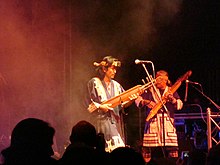


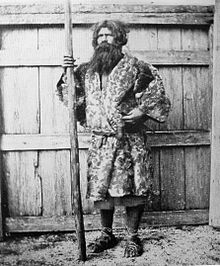






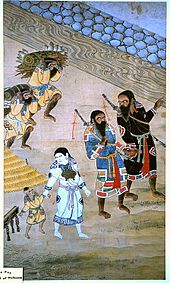
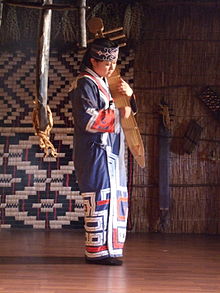


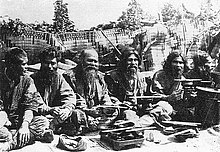


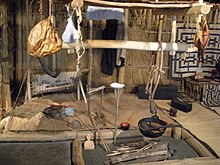
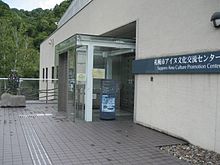



No comments:
Post a Comment